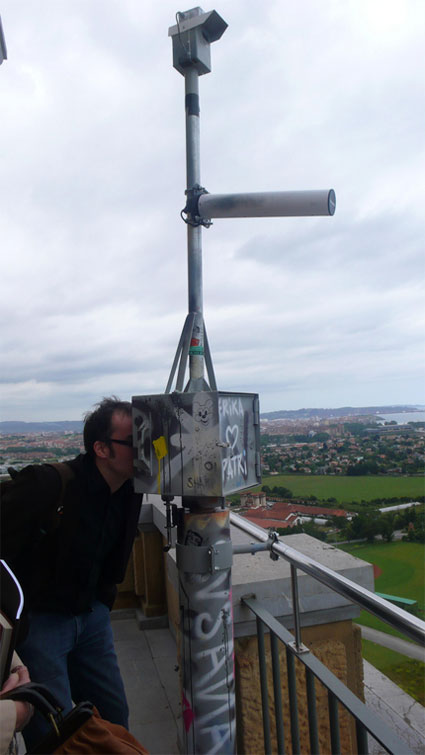Visualising Informational Territories
Empiricamente é possível detectar os “territórios informacionais” seja por pesquisa etnográfica mostrando os usos dos espaços por usuários de tecnologias móveis, seja estruturamente analisando as infra-estruturas de redes nos espaços urbanos. Mas nada melhor que poder ver esses territórios. A exposição “Banquete_nodos y redes”, no LAboral Art and Industrial Creation Centre em Gijón, Astúrias, apresentou “Observatório” de Clara Boj and Diego Diaz , de Valencia, Espanha. Eles projetaram um telescópio, chamado de Observatorio, no projeto Red Libre Red Visible (Free Network, Visible Network). Obervatorio busca refletir sobre o impacto das redes sem fio nos espaços urbanos, informando aos usuário sobre o estado das redes wireless em um determinado lugar. É possível ver as redes sem fio sobre Gijón, visualizando assim um o território informacional. O projeto pode ser visto até novembro de 2008 e depois vai ao ZKM | Center for Art and Media em Kartlruhe, no primeiro semestre de 2009.Vejam a descrição do telescópio (via we make money not art ):

“The sightseeing telescope, installed on the Laboral tower, tracks and shows where Gijon’s wifi networks are located in real time. You can visualize them on the screen of the telescope, swing it around and see which areas have a denser wifi coverage, and get additional data such as which ones among these networks are open or private. Because Observatorio is programmed to try and connect to any open network available in the area, it can send the information from the observation tower to the exhibition hall, where it is displayed on a big screen. If there is no open networks detected in the area, Observatorio remains separated from the main exhibition space, located in another building. A modification of these networks is also offered, showing an ideal configuration in which the local residents of large areas in the city could gain or share access to it. After having installed Observatorio, the artists discovered many more open nodes than they expected. While testing the project at their studio in Valencia, they couldn’t find more than 5% of open networks. In Gijón the percentage is higher, around 30% in the LABoral area. From the tower Observatorio can reach theoretically almost the whole city of Gijón. The device comprises a high power uni-directional WiFi antenna with a 30º aperture, able to detect wireless networks within 1 to 4 kilometers depending on the number of obstacles encountered; a video surveillance camera with a telephoto lens with the same aperture as the WiFi antenna; and a viewer which, like a periscope, offers a real time image taken by the camera, with the WiFi networks detected by the antenna placed geographically on it.
